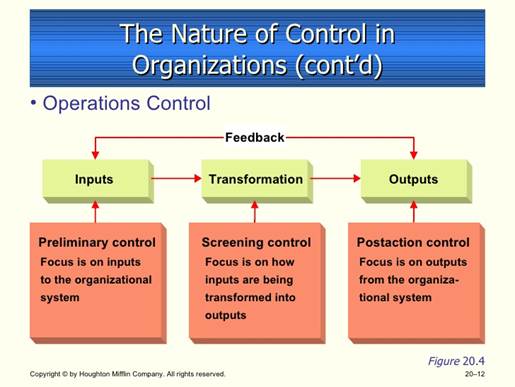Forms of operations control and their specifics.
Operations control focuses on the processes used to transform resources into products or services. Most firms use multiple control systems.

A) Preliminary Control
Preliminary control attempts to monitor the quality of financial, physical, human, and information resources before they actually become part of the system. Thus, preliminary control concentrates on inputs to the system early in the overall process.
Extra Example: Ford Motor Company used preliminary control when it raised the product quality standards that must be met by its suppliers, for example, and pressured them to lower their costs so that Ford can lower its own costs.
Preliminary control is also called steering control or feedforward control.
B ) Screening Control
Screening control relies heavily on the feedback process. Thus, it takes place during the transformation process. As the outputs are produced, they are screened at checkpoints to make sure they meet the standards. Preliminary control, also known as steering control or feedforward control, focuses on the resources that the organization brings in from the environment. It attempts to monitor the quality or quantity of these resources before they enter the organization.
Screening control is also called yes/no control or concurrent control.
C ) Postaction Control
Postaction control monitors the output or results of the organization after the transformation process is complete. Thus, postaction control focuses on determining if the outputs of the organization meet the established standards. Post action control, also known as feedback control, focuses on the outputs of the organization after the transformation process is complete. Although postaction control used alone may not be as effective as preliminary or screening control, it can provide management with information for future planning. Post action control also may be used as a basis for rewarding employees.
Extra Example: Levi Strauss relies heavily on post action control. The firm requires that every pair of jeans it makes be inspected before it leaves the factory.